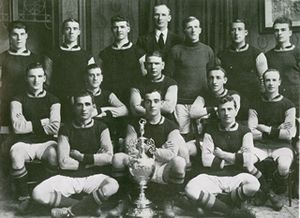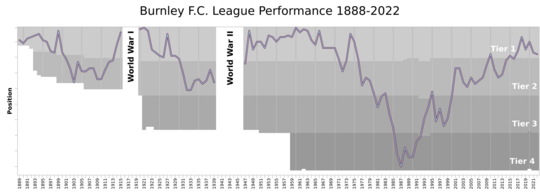History of Burnley F.C. facts for kids
Burnley Football Club is a professional football team from Burnley, Lancashire, England. It was started on May 18, 1882, by members of a rugby club called Burnley Rovers. They decided to switch from rugby to football. Burnley became a professional club in 1883, which means players were paid. This helped convince the Football Association (FA) to allow payments to players in 1885.
Burnley first played in the FA Cup in 1885–86. They were also one of the twelve original teams that formed the Football League in 1888–89. The team had some tough times early on, even being sent down to the Second Division in 1897. But they quickly bounced back!
In 1914, Burnley won the FA Cup for the first and only time. Then, in the 1920–21 season, they became champions of England for the first time. They even set an English record by going 30 matches without losing! Burnley stayed in the top league until 1930.
From the 1950s to the 1970s, Burnley was known for finding and training young players. They were one of the first clubs to build a special training ground. In 1959–60, Burnley won their second league championship. The town of Burnley, with about 80,000 people, became one of the smallest towns to have an English top-tier champion. Since then, the club has often moved between the top two leagues, sometimes going up to the Premier League and then back down.
Contents
How Burnley FC Started (1882–1888)
On May 18, 1882, the Burnley Rovers rugby club decided to switch to playing football. Many other local clubs were doing the same. The club's secretary, George Waddington, suggested dropping "Rovers" from the name. He thought the club should simply be called "Burnley" to represent the town. Everyone agreed! The new team was a mix of former rugby players and new players who already knew football.

Burnley won their first recorded football game 4–0 against Burnley Wanderers in August 1882. They played in blue and white, the old rugby club's colours, at their home ground, Calder Vale. Their first official game was in October 1882 in the Lancashire Senior Cup, which they lost 8–0.
In February 1883, Burnley moved to a new pitch next to the cricket field at Turf Moor. Both clubs have been there ever since! Only Preston North End has played at the same ground for longer. Burnley paid £65 to help set up the new ground. They played their first match at Turf Moor on February 17, losing 6–3.
Burnley won their first trophy, the Dr Dean's Cup, in June 1883. They beat Burnley Ramblers 2–1 in the final. They won this cup again in 1884 and many times after. In their first season, Burnley played 34 matches, winning 19, drawing 1, and losing 14.
By the end of 1883, the club became professional, meaning they paid their players. They signed many Scottish players, who were considered the best. At first, Burnley didn't join the FA Cup because the FA didn't allow professional players. But in 1885, the FA changed its rules and allowed professionalism.
Burnley first played in the FA Cup in 1885–86. However, most professionals were still not allowed to play that year. So, Burnley used their reserve team and lost 11–0 to Darwen Old Wanderers. This is still the club's biggest defeat.
In October 1886, Turf Moor became the first football ground visited by a member of the Royal Family. Prince Albert Victor, Queen Victoria's grandson, watched a match. To celebrate, Burnley received special white jerseys with a blue sash and the royal coat of arms. They wore this crest until 1895. In the 1887–88 FA Cup, Burnley got revenge on Darwen Old Wanderers, winning 4–0 for their first FA Cup victory.
Joining the Football League (1888–1912)
In 1888, Aston Villa director William McGregor created the Football League. It was the world's first football league competition. Burnley was one of the twelve founding members. In their second league game, William Tait scored the club's first league hat-trick, helping Burnley win 4–3 against Bolton Wanderers. Burnley finished ninth in their first league season.
In March 1889, Jack Yates became the first Burnley player to play for the England national team. He scored three goals in a 6–1 win against Ireland. Burnley finished near the bottom in 1889–90, but they won their first Lancashire Senior Cup that year. At this time, Burnley's nicknames included "Turfites" or "Royalites."
In 1891–92, Burnley had their biggest league win ever, beating Darwen 9–0. In 1894, Burnley hired their first team manager, Harry Bradshaw. Before this, a committee or secretary chose the team.
Under Bradshaw, Burnley was relegated to the Second Division for the first time in 1896–97. They came back up the very next season by winning the Second Division. The last game against Stoke was famous for ending 0–0 because both teams only needed a draw to get promoted. It was called "the match without a shot at goal." After this, the Football League changed the rules to automatic promotion and relegation. Burnley finished third in their first season back in the top league, which was their highest finish at the time.
Burnley was relegated again in 1899–1900. Their goalkeeper, Jack Hillman, tried to trick opponents Nottingham Forest in the last game. He was suspended for the next season. This is one of the earliest known cases of trying to fix a football match.
Burnley stayed in the Second Division for many years. They finished last in 1902–03 but were allowed to stay in the league. The club had financial problems, and managers came and went. In 1907, a Burnley fan named Harry Windle became a director and later chairman. He helped improve the club's money situation.
In April 1910, manager Spen Whittaker died in an accident. John Haworth became the new manager. He signed Burnley's first overseas player, Max Seeburg from Germany. Haworth also changed the club's colours from green to claret and blue, like the champions Aston Villa. He hoped this would bring good luck! The team's performance improved, and they almost got promoted in 1911–12.
FA Cup Glory and Later Challenges (1912–1946)
In 1912–13, Burnley was promoted to the First Division. They scored the most goals in the country (88 goals) that season. They also reached the FA Cup semi-finals for the first time.
The next season, 1914, Burnley won their first major trophy: the FA Cup! They beat Liverpool 1–0 in the final at Crystal Palace. Bert Freeman scored the only goal. Burnley was the first team to beat five First Division clubs in one FA Cup season. Burnley's captain, Tommy Boyle, received the trophy from King George V. It was the first time a king attended an FA Cup final. During this time, Turf Moor's capacity grew to 50,000 fans, almost as many as the town's male population.
Football was stopped during the First World War. Several Burnley players, including Jonathan Brown and William Pickering, sadly died during the war. When football started again in 1919–20, Burnley finished second. Then, in the 1920–21 season, they won the First Division championship for the first time! They lost their first three games but then went 30 matches without a defeat. This was an English record for unbeaten league games in one season until Arsenal's "Invincibles" in 2003–04. Burnley finished third the next season and 15th in 1922–23.
In February 1924, Burnley beat Huddersfield Town 1–0 in the FA Cup. A record 54,775 fans watched the game at Turf Moor. A few months later, manager Haworth died. Albert Pickles became the new manager.
Burnley had a tough time under Pickles. In 1925, they sold key player Bob Kelly to Sunderland for £6,500. This was a world record transfer fee at the time! In 1925–26, Burnley avoided being relegated by just one point. They lost their opening game 10–0 but won three of their last five matches. This included a 7–1 away win against Birmingham, where Louis Page scored a club record six goals.
Burnley finished fifth in 1926–27. In 1927–28, George Beel and Louis Page scored 57 league goals together. Beel scored a club record 35 goals in the league. In November 1927, Turf Moor hosted its only senior international football match, between England and Wales. Burnley's Jack Hill captained England, and Louis Page also played.
Jerry Dawson, who played 569 games for Burnley (a club record), retired in 1929. In 1929–30, Burnley was relegated to the Second Division. Fewer fans came to games, and the club had financial problems. They had to sell important players like Jack Bruton and Joe Devine.
Burnley struggled in the Second Division and almost got relegated again in 1931–32. George Beel, Burnley's all-time top goal scorer with 188 goals, left the club that season. Fan numbers dropped, so a supporters' club was formed to bring interest back. This helped improve attendance a little.
Before the Second World War, Burnley usually finished in the middle of the league table. They reached the FA Cup semi-finals in 1935. That same year, the club changed its kit to white shirts and black shorts. In March 1936, Tommy Lawton became the youngest player to play for Burnley at 16 years old. He scored 16 goals in 25 games before moving to Everton for £6,500, a record fee for a player under 21. Football continued during the war with special wartime leagues and cups. In 1946, Burnley changed their colours back to claret and blue.
A Golden Era for Burnley (1946–1976)
In 1946–47, the first season after the war, Burnley finished second in the Second Division and were promoted. Their defence was so strong it was called the "Iron Curtain" because they only let in 29 goals in 42 league games. They also reached the 1947 FA Cup Final, but lost 1–0 to Charlton Athletic at Wembley.
Burnley finished third in 1947–48. That season, Turf Moor had its highest average attendance ever, with 33,621 fans per game. The biggest crowd was 52,869 against Blackpool.
In 1954, former player Alan Brown became manager, and Bob Lord became chairman in 1955. Under them, Burnley became a very modern club. In 1955, they built one of the first special training grounds at Gawthorpe. It had a medical room, a gym, and several pitches. Brown even helped dig the ground himself!
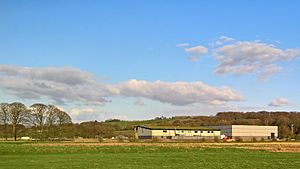
Burnley became famous for its youth policy and scouting system. They found many talented young players, especially from the North East of England, Scotland, and Northern Ireland.
In 1958, former Burnley player Harry Potts became manager. His team was built around captain Jimmy Adamson and Jimmy McIlroy, who was the team's main creative player. Most of the squad came from the club's own youth academy. Only two players, McIlroy and Alex Elder, cost money to buy. Potts often used a 4–4–2 formation, which was not common then. Their playing style was called "Total Football" and was praised for being smooth and skilled.
The 1959–60 season was very exciting. Burnley won their second First Division championship on the very last day! They beat Manchester City 2–1 with goals from Brian Pilkington and Trevor Meredith. Burnley had not been at the top of the league table until that final match. The Daily Mirror newspaper noted that Burnley, a team of "quiet men" who cost less than £15,000, "snatched" the title. With only 80,000 people, Burnley became one of the smallest towns to have an English top-tier champion.
Because they won the league, Burnley played in a European competition for the first time in 1960–61. They beat former finalists Stade de Reims but were knocked out by Hamburger SV in the quarter-finals. Burnley also shared the FA Charity Shield with Wolverhampton Wanderers and reached the FA Cup semi-final.
In 1961–62, Burnley finished second in the First Division and reached the 1962 FA Cup Final, but lost to Tottenham. Jimmy Robson scored Burnley's goal. Jimmy Adamson was named the best player of the year.
In 1961, the rule about a maximum wage for players was removed. This meant that clubs from smaller towns like Burnley couldn't compete financially with bigger clubs. The departure of key players like McIlroy in 1963 and Adamson's retirement in 1964 also affected the club. However, Burnley stayed in the First Division throughout the 1960s, finishing third in 1962–63 and 1965–66. In the latter season, Burnley's Willie Irvine was the league's top goal scorer.
Because of their third-place finish in 1965–66, Burnley played in the 1966–67 Inter-Cities Fairs Cup. They reached the quarter-finals but were knocked out by Eintracht Frankfurt. They also reached the League Cup semi-final in 1968–69.
After 12 years, Harry Potts stepped down as manager in 1970 and was replaced by Adamson. But Adamson couldn't stop the team's decline, and Burnley was relegated in 1970–71. This ended a 24-season run in the top league.
Burnley won the Second Division title in 1972–73, losing only four times in 42 matches. They then won the 1973 FA Charity Shield against Manchester City. In 1973–74, they finished sixth in the First Division and reached the FA Cup semi-finals. The next season, they had a shocking FA Cup defeat at home to Wimbledon, who were a non-league team at the time. Adamson left in 1976, and Burnley was relegated from the First Division again. Fewer fans came to games, and the club had more debt. They had to sell star players like Martin Dobson and Leighton James, which led to a quick decline.
Tough Times and Comeback (1976–2009)
Burnley spent three seasons in the Second Division, winning the Anglo-Scottish Cup in 1978–79. But then they were relegated to the Third Division for the first time in 1979–80. They only won 6 of 42 league games that season.
In September 1981, the club was in the relegation zone and almost bankrupt. Chairman Bob Lord retired. But under manager Brian Miller, Burnley had only three more defeats after October and were promoted as champions in 1981–82! They were relegated again the next year, but they reached the FA Cup quarter-finals and the League Cup semi-finals, beating Tottenham and Liverpool in the latter.
The club changed managers several times looking for success. In 1984, John Benson became manager, and Burnley was relegated to the Fourth Division for the first time at the end of the 1984–85 season.
Brian Miller returned as manager in 1986. For the 1986–87 season, the Football League introduced automatic relegation to the Football Conference, which is the top non-league division. Burnley had a very difficult season. They went into the last league match in last place. They needed to win against Orient, for Lincoln City to lose, and for Torquay United not to win. Burnley won 2–1 in front of over 15,000 fans, with goals from Neil Grewcock and Ian Britton. Torquay drew, and Lincoln lost, so Burnley stayed in the Fourth Division!
In 1988, Burnley played Wolverhampton Wanderers in the Associate Members' Cup Final at Wembley, losing 2–0. More than 80,000 people watched, a record for a game between two fourth-tier teams.
In 1990–91, Burnley reached the Fourth Division play-offs but lost in the semi-final. The next season, 1991–92, Burnley won the league title under new manager Jimmy Mullen. This was the last season of the Fourth Division before the league was reorganized. By winning the fourth tier, Burnley became only the second club to win all four professional divisions of English football, after Wolverhampton Wanderers.
In 1993–94, Burnley won the Second Division play-offs and were promoted to the second tier. They beat Stockport County 2–1 in the final. They were relegated after just one season. Because of their time in the second tier, Burnley received £2.25 million from the Football Trust. This money helped turn Turf Moor into an all-seater stadium, as required by new safety rules. The new North and Jimmy McIlroy Stands were built in 1996, costing over £5 million and bringing Turf Moor's capacity to almost 23,000.
In 1997–98, a last-day win saved Burnley from being relegated back to the fourth tier. Chris Waddle was player-manager that season, but Stan Ternent took over in the summer. Burnley finished second in 1999–2000 and were promoted to the second tier. Their striker and lifelong fan, Andy Payton, was the division's top goal scorer.
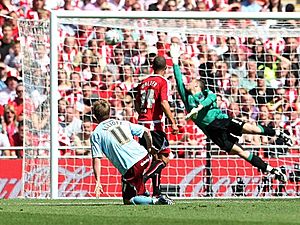
Burnley almost reached the promotion play-offs in 2000–01 and 2001–02. In 2002, financial problems almost caused the club to go into administration (a type of bankruptcy). In 2002–03, Burnley finished 16th and reached the FA Cup quarter-finals. Ternent was sacked in 2004, and Steve Cotterill became manager.
In 2006, Turf Moor and Gawthorpe were sold for £3 million to help solve the club's financial problems. In 2006–07, Burnley went 19 games without a win but managed to stay in the Championship.
Cotterill left in November 2007, and Owen Coyle took over. In 2008–09, Coyle's first full season, Burnley finished fifth in the Championship. They won the play-offs, beating Sheffield United in the final with a goal from Wade Elliott. This meant promotion to the top league after 33 years! Burnley also reached the League Cup semi-finals, beating Chelsea and Arsenal along the way. They lost to Tottenham Hotspur in a dramatic semi-final.
Premier League and European Football (2009–2022)
After their promotion, Burnley became one of the smallest towns to have a Premier League club. They started the 2009–10 season well, becoming the first newly promoted team to win their first four home games, including a 1–0 victory against champions Manchester United.
Coyle left in January 2010 to manage local rivals Bolton Wanderers. He was replaced by former player Brian Laws, under whom Burnley's form got worse, and they were relegated after just one season in the Premier League. Laws was dismissed in December 2010 and replaced by Eddie Howe. Howe guided the team to an eighth-place finish in 2010–11. In October 2012, Howe left Burnley to rejoin Bournemouth. Sean Dyche became the new manager.
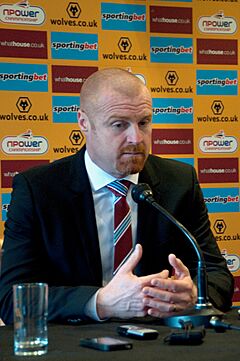
Before the 2013–14 season, Turf Moor and Gawthorpe returned to club ownership. Many thought Burnley would be relegated, as Dyche had a small budget and their top goal scorer, Charlie Austin, had left. But in Dyche's first full season, Burnley finished second and were promoted back to the Premier League! The new strike partnership of Danny Ings and Sam Vokes scored 41 league goals together. Dyche used only 23 players all season and only paid one transfer fee for a player.
Burnley finished 19th the next season and were relegated back to the Championship. But in 2015–16, they won the Championship title! They went 23 league games without losing. Their new signing, Andre Gray, scored 23 goals and was the league's top scorer.
In 2016–17, Burnley finished 16th in the Premier League, staying up for a second season in a row for the first time in the Premier League era. In the FA Cup that season, they had a shocking 1–0 home defeat to non-league club Lincoln City. During this year, the club's new Barnfield Training Centre was finished, replacing the 60-year-old Gawthorpe. Dyche was involved in the design, showing the club's focus on its future.
Burnley finished seventh in the 2017–18 season, their highest league finish since 1973–74. This meant they qualified for the 2018–19 UEFA Europa League, their first European competition in 51 years! They beat Aberdeen and İstanbul Başakşehir but were knocked out by Greek side Olympiacos.
The 2019–20 season was stopped for three months because of the COVID-19 pandemic. Games were played without fans. Burnley finished 10th, just missing out on European qualification. In December 2020, an American company called ALK Capital bought 84% of Burnley for £170 million. This was the first time the club was not owned by local businessmen. ALK borrowed a lot of the money, and these debts were transferred to the club. This meant Burnley went from having no debt to owing around £100 million.
Recent Years (2022–present)
In April 2022, Sean Dyche was sacked after a series of poor results. Burnley won 11 points from eight matches under temporary manager Mike Jackson, but they were relegated back to the Championship after losing on the final day of the season.
In June, Vincent Kompany from Belgium was appointed Burnley's manager. He was the first manager from outside the British Isles to manage the club. In his first few months, he signed 16 new players, mostly young and from other countries. Kompany also brought in a new style of play, focusing on keeping the ball and attacking.
Burnley secured promotion back to the Premier League with seven matches left in the 2022–23 season, which was a Championship record! They then won the Championship title after beating local rivals Blackburn Rovers 1–0. Burnley earned 101 points that season, becoming the first club to pass 100 points in the Championship since Leicester City in 2014. Other managers called Burnley the "best Championship team in 25 years."
However, in the 2023–24 season, Burnley was relegated from the Premier League again, finishing 19th with a club record low of 24 points. Some critics said Kompany's tactics and inexperience were a problem. He was also criticized for buying too many inexperienced players, which made the team less competitive. Despite this, Kompany later moved to Bayern Munich for a fee of £10.2 million, making him one of the most expensive managers in history.


